|
|
|
Sort Order |
|
|
|
Items / Page
|
|
|
|
|
|
|
| Srl | Item |
| 1 |
ID:
132781
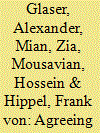

|
|
|
|
|
| Publication |
2014.
|
| Summary/Abstract |
Iran is negotiating with a group of six states over the future of its nuclear program. In November 2013, Iran and the P5+1 (China, France, Germany, Russia, the United Kingdom, and the United States) agreed to a Joint Plan of Action that seeks to reach a "comprehensive solution" by July 20, 2014.
The goal is an agreement on a set of measures that can provide reasonable assurance that Iran's nuclear program will be used only for peaceful purposes and enable the lifting of international sanctions imposed on Iran over the past decade because of proliferation concerns.
A key challenge is to reach agreement on limiting Iran's uranium-enrichment program, which is based on gas centrifuges, in a way that would enable Iran to meet what it sees as its future needs for low-enriched uranium (LEU) fuel for nuclear research and power reactors while forestalling the possibility that this program could be adapted to quickly produce highly enriched uranium at levels and in amounts suitable for use in nuclear weapons
|
|
|
|
|
|
|
|
|
|
|
|
|
|
|
|
| 2 |
ID:
132787


|
|
|
|
|
| Publication |
2014.
|
| Summary/Abstract |
China will soon have its first credible sea-based nuclear deterrent, according to a U.S. Defense Department report released last month.
The report said Beijing is placing a "high priority" on updating and developing its submarine force and will soon deploy the Julang-2 (JL-2) submarine-launched ballistic missile (SLBM) on its Jin-class submarine.
The Defense Department is required by law to submit an annual report to Congress on China's military capabilities and force modernization.
|
|
|
|
|
|
|
|
|
|
|
|
|
|
|
|
| 3 |
ID:
132785
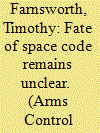

|
|
|
|
|
| Publication |
2014.
|
| Summary/Abstract |
A new draft of the European Union's proposed international code of conduct for activities in outer space was released during a May 27-28 meeting in Luxembourg, but despite the revisions, it is unclear which countries will support the code.
"We are fully aware that [the current draft] does not meet the concerns and expectations of all," Jacek Bylica of the EU, chairman of the meeting, said in his closing remarks.
The meeting was the last of a series of three consultations that began in Kiev in May 2013 and continued in Bangkok in November 2013. The meetings represented an effort to expand the group of negotiating states beyond the established spacefaring countries. (See ACT, May 2013.) During the three meetings, officials from more than 80 countries met to discuss elements of a code, with many disagreements remaining throughout the process
|
|
|
|
|
|
|
|
|
|
|
|
|
|
|
|
| 4 |
ID:
132783


|
|
|
|
|
| Publication |
2014.
|
| Summary/Abstract |
Efforts to resolve several issues arising from Syria's chemical weapons program appear to be moving slowly, even as the destruction of Syrian chemical weapons material aboard a U.S. ship in the Mediterranean Sea began this month.
Officials from the Organisation for the Prohibition of Chemical Weapons (OPCW) and some of its key member states have highlighted the need for Syria to destroy its chemical weapons production facilities and resolve questions about its declaration of its arsenal last year.
For months, Robert Mikulak, the U.S. ambassador to the OPCW, has been castigating Syria for its failure to destroy its 12 remaining former chemical weapons production facilities. Destruction of such facilities is a required step under the Chemical Weapons Convention (CWC), which Syria joined last fall. Under a timetable for chemical weapons destruction approved by the OPCW Executive Council last November, that task was to be completed by March 15.
|
|
|
|
|
|
|
|
|
|
|
|
|
|
|
|
| 5 |
ID:
132782
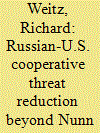

|
|
|
|
|
| Publication |
2014.
|
| Summary/Abstract |
The crisis in Ukraine probably has ruined prospects for another formal Russian-U.S. arms control agreement during the Obama administration's second term. Even before the crisis over Crimea, Russian and U.S. negotiators differed sharply on their preferred outcomes for reducing their strategic nuclear forces further, eliminating or consolidating nonstrategic nuclear weapons in Europe, constraining national and theater strategic defenses, or renewing conventional arms limitations in Europe.
|
|
|
|
|
|
|
|
|
|
|
|
|
|
|
|
| 6 |
ID:
132786
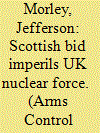

|
|
|
|
|
| Publication |
2014.
|
| Summary/Abstract |
The future of the United Kingdom's nuclear arsenal is in the hands of 4.1 million Scottish voters who go to the polls Sept. 18 to decide whether to end the country's 307-year union with England and become an independent country.
If the ballot proposal is approved, the ruling pro-independence Scottish National Party (SNP) has pledged to evict the UK fleet of four nuclear-armed submarines from the naval base at Faslane on Scotland's west coast by 2020. Having no comparable submarine base, the UK government would then face expensive choices about how to maintain its exclusively sea-based nuclear force.
"It would be an enormous exercise to reproduce the facilities elsewhere," the UK Ministry of Defence said in an October 2013 analysis of Scottish independence. "It would cost billions of pounds and take many years."
|
|
|
|
|
|
|
|
|
|
|
|
|
|
|
|
| 7 |
ID:
132788
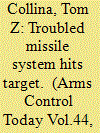

|
|
|
|
|
| Publication |
2014.
|
| Summary/Abstract |
The problem-plagued missile defense system designed to protect the United States from potential attacks from North Korea and Iran successfully intercepted a target missile last month, clearing the way for the Obama administration to move ahead with its plans to expand the system.
In the June 22 test, a ground-based interceptor (GBI) missile launched from Vandenberg Air Force Base in California collided with an intermediate-range ballistic missile target launched from the Army's Kwajalein Test Site in the Marshall Islands, according to a Missile Defense Agency (MDA) press release.
|
|
|
|
|
|
|
|
|
|
|
|
|
|
|
|
| 8 |
ID:
132784


|
|
|
|
|
| Publication |
2014.
|
| Summary/Abstract |
The U.S. government announced on June 27 that it will not produce or acquire anti-personnel landmines and that it intends to join the global Mine Ban Treaty at some point in the future, a stance that did not satisfy activists and officials pressing to rid the world of landmines.
The U.S. government is "diligently pursuing…solutions that would be compliant" with the treaty and "that would ultimately allow us to accede" to it, Douglas Griffiths, the U.S. ambassador to Mozambique, said in a statement delivered at a review conference for the treaty being held in Maputo. The parties to the treaty, which entered into force in 1999, hold these conferences every five years.
Supporters of the treaty voiced disappointment throughout the conference that the United States has yet to join the treaty, which President Barack Obama endorsed as a U.S. senator in 2007. Although U.S. officials told reporters that their review of U.S. landmine policy, which began five years ago, is not completed, the announced changes fell short of proponents' hopes for U.S. accession to the treaty.
|
|
|
|
|
|
|
|
|
|
|
|
|
|
|
|
| 9 |
ID:
132789
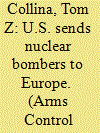

|
|
|
|
|
| Publication |
2014.
|
| Summary/Abstract |
The U.S. Air Force sent five nuclear-capable bombers to Europe in early June as President Barack Obama traveled to the region to reassure allies against the backdrop of Russia's recent annexation of Crimea and separatist conflict in Ukraine.
All five bombers went to the air force base at Fairford in the United Kingdom. Two B-52 bombers from Barksdale Air Force Base in Louisiana and one from Minot Air Force Base in North Dakota arrived on June 4 for a two-week deployment, according to an Air Force press release. "Airmen will train and integrate with U.S. and allied military forces in the region," the Air Force said, adding that the bombers did not carry live weapons.
Four days later, two B-2 bombers based at Whiteman Air Force Base in Missouri flew to Fairford as well, the Air Force said. As the most sophisticated U.S. bomber for penetrating enemy air defenses, the presence in Europe of nuclear-capable B-2s was reported by media outlets as possibly sending a pointed message to Moscow.
|
|
|
|
|
|
|
|
|
|
|
|
|
|
|
|
|
|
|
|
|